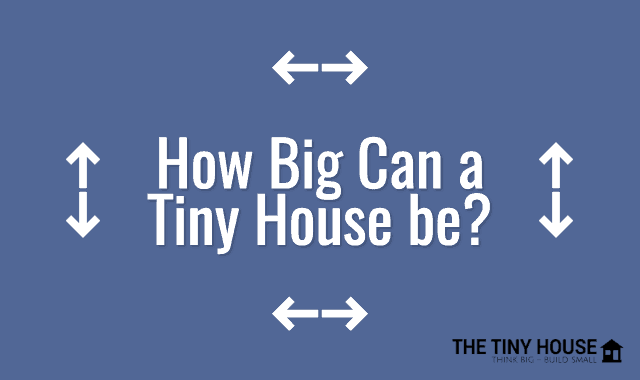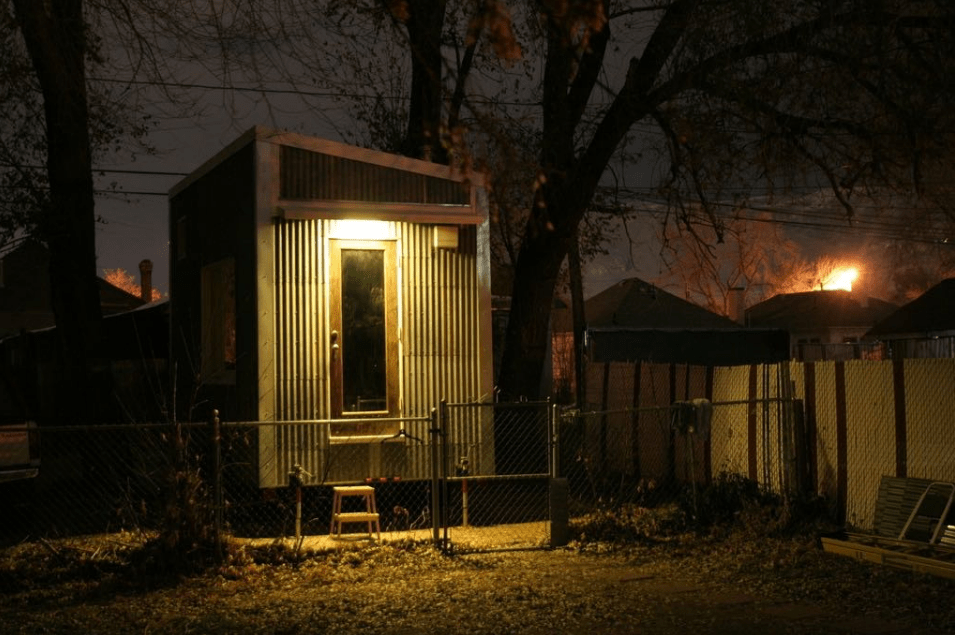How big can a tiny house be? For people who aren't bothered about owning big houses and having lots of possessions, we sure do seem to worry a lot about size!
I'm often asked, “how big can a tiny house be?”, “when is a tiny house actually just a small house?”, and “how big tiny is a typical tiny house?”.

Sometimes it feels like tiny house owners are in a competition to own the smallest tiny house. Other times, it feels like the community looks down on tiny house owners who opt for larger tiny houses.
Of course, tiny for tiny's sake isn't what this movement is all about, but there must be some kind of accepted size range, right?
So, how big can a tiny house be and how big should your tiny house be?
How Big Can a Tiny House be?
Of course, you know the answer to this question. There's no explicit rule as to how big or small a tiny house has to be. There's no Tiny House Sizing Police Department.
Your tiny house can be any size you want it to be. And if it's so big that it meets your area's zoning requirements, who cares, as long as you're happy living in it?
That said, if you really do want a rule of thumb, it would seem that tiny houses usually range between around 60 and 400 square feet. You could possibly extend this range up to around 1000 square feet, but you're venturing into “small house” territory here.
What you might notice as you do your research, is that a lot of tiny houses are around the 200 square foot mark, so that would seem to be the norm. A standard college dorm room is likely to be around this size. My tiny house is approximately 150 square feet, so just a little bit smaller.

How to Decide How Big Your Tiny House Should be
If you're not sure how how big to make your tiny house, use 200 square feet as your starting point. Could you imagine living in a space that size?
Look at tiny houses of that size and ask what you would want to add or take away. Keep doing that with a range of different-sized tiny houses, until you think you've found the size that will be able to accommodate everything you need and nothing more.
It's also worth knowing whether you want a tiny house on wheels or a tiny house built on a foundation. If you want to build on a trailer, you'll need to take road requirements into account.
“If you want to be able to pull your house down a highway without a special permit, it must conform to certain size limits. In most U.S. states this maximum size is 13.5-feet tall, 8.5-feet wide, and 40-feet long – 65-feet maximum including the tow vehicle.” – Road Limits for Tiny Houses on Trailers, by Tiny House Design
If you want to build on a foundation, you'll need to take zoning requirements and codes into account (or choose to ignore them and hope you don't get caught). Of course, these vary depending on where you live, but I'd recommend reading Cracking The Code if you're thinking of going this route.
How Big are Other People's Tiny Houses?
To give you a feel for the different sizes you could go for, and what those sizes might look like and give you, here are a few tiny houses of different sizes.
From smallest to largest…
The 50 Square-Foot Tiny House

Photo courtesy of Rob Greenfield
One of the smallest tiny houses I've come across is Rob Greenfield's Teeny Greeny. This house measures 5 feet by 10 feet, making it only 50 square feet. Of course, there's not much to this tiny house! When he bought it from Craigslist (for $950), it was completely empty with no loft or anything.
If you want a tiny house this small, you'll need to sacrifice a lot. When Rob lived in this tiny house, he swam in the ocean or used water and a cloth to clean himself instead of showering. He collected rainwater and used solar power. A house this small doesn't have space for a shower, kitchen, and so on!
For more information about how Rob was able to live in such a small space, as well as why he decided to do this, read his Teeny Greeny articles.
The 175 Square-Foot Tiny House

Photo courtesy of Tiny House Swoon
The Hexagon House was designed for the tiny house owner who wants to live off-grid, in a communal setting. Obviously, sharing resources with other people, like outdoor storage spaces or a communal toilet, allows you to reduce the size of your tiny house considerably.
As you can see if you peek inside, going really tiny doesn't mean you have to compromise on style or quality. This tiny house was built using a combination of salvaged materials and high-end appliances.
This house makes good use of space by featuring a slide-out bed as well as a loft area. It also manages to fit in a small kitchen area, a shower, and a fridge, without feeling at all cramped.
The 204 Square-Foot Tiny House

Photo courtesy of Backcountry Tiny Homes
This tiny house was designed by its owners to include incredible amounts of storage space. There are storage boxes all over the place!
Inside, it boasts a kitchen, a composting toilet, a shower area, a living space complete with a guest bed, a small storage loft, and a sleeping loft.
It takes space efficiency to the next level, with its roof that also functions as a deck! This brings the total area up to 383 square foot.
The really good news here is that you can buy the plans for this tiny house, or have the house built for you, from Backcountry Tiny Homes.
The 557 Square-Foot Tiny House

Photo courtesy of Tumbleweed Tiny House Company
You've probably heard of the Tumbleweed Tiny House Company, but are you aware that they sell plans for tiny cottages as well as plans for normal tiny houses? One of their models is the Whidbey, which can be built to have either one or two downstairs bedrooms, upstairs storage space, a kitchen, a bathroom, and a great room.
To see how this tiny house can be modified and what the space can look like, see Deidre's 960 square-foot version and Lyndsey and Tom's 600 square-foot one. There's a lot more room than in your typical tiny house, but these cottages still feel very minimalist and cosy.
How Big Can a Tiny House be? You Decide.
As you can see, there is no set tiny house size, but there is a range of “normal” sizes.
The most important thing is that your tiny house is big enough for you (and your family) and small enough that it brings you the benefits of tiny house living. If you decide a tiny house is too small for you, go for a small house instead and work on getting the practical and psychological benefits of tiny house living in other ways.
How big can a tiny house be, in your opinion? What size will yours be?


